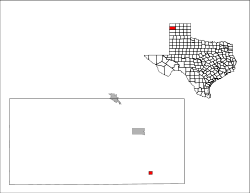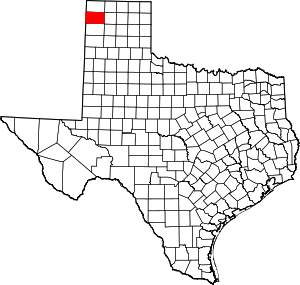Channing, Texas
Channing is a city in Hartley County, Texas, in the United States. It is the county seat of Hartley County.[5] As of the 2010 census, the city population was 363.
Channing, Texas | |
|---|---|
XIT Ranch General Office in Channing | |
Location of Channing, Texas | |
 | |
| Coordinates: 35°41′1″N 102°19′55″W | |
| Country | United States |
| State | Texas |
| County | Hartley |
| Area | |
| • Total | 0.99 sq mi (2.57 km2) |
| • Land | 0.99 sq mi (2.57 km2) |
| • Water | 0.00 sq mi (0.00 km2) |
| Elevation | 3,806 ft (1,160 m) |
| Population (2010) | |
| • Total | 363 |
| • Estimate (2019)[2] | 344 |
| • Density | 346.77/sq mi (133.87/km2) |
| Time zone | UTC-6 (Central (CST)) |
| • Summer (DST) | UTC-5 (CDT) |
| ZIP code | 79018 |
| Area code(s) | 806 |
| FIPS code | 48-14260[3] |
| GNIS feature ID | 1354290[4] |
History
Channing was founded in 1888 by George Channing Rivers, a paymaster for the Fort Worth and Denver City Railway.[6] The settlement was originally called Rivers. Since the name Rivers duplicated another community in Texas, the name was changed to Channing later that year.[7] Channing developed directly from its association with the XIT Ranch, a property that once included land in as many as ten counties in the Texas Panhandle. In 1891, Willis D. Twitchell platted Channing's business district. At that time, Channing was the headquarters of the XIT.[8] Albert Boyce, the ranch's general manager and one of the most prominent early citizens, built the first house in the community. By 1900, Channing had two stores, a post office, lumber yard, and school.[6] Two elections, one in November 1896 and the other in 1903, were required for Channing to replace Hartley as county seat.[7][9] The frame courthouse was pulled to Channing on wheels by mounted XIT cowboys in 1903. A brick courthouse was completed in 1906 and the original courthouse was converted into the once famous Hotel Rivers.[8] One of the first public libraries in the Panhandle was established in 1908 by a local women's club. The estimated population at this time was about 600.
The XIT, which conducted most of its business from Channing, was the town's chief customer until liquidation of the ranch in 1911. The local economy was severely impacted, although the real estate market temporarily thrived from the sale of XIT lands.[9] A fire swept through the business district on September 6, 1931, destroying seven buildings including Hotel Rivers. By 1940, Channing had an estimated population of 475 with several businesses, a high school, and three churches. A restored XIT office building is located in Channing as a museum.
Channing was incorporated in 1960. At the time of incorporation, the population was 390.[7] The number of inhabitants declined to 336 in 1970, 304 in 1980, and 277 in 1990, mainly because of its accessibility to larger communities like Dalhart and Amarillo. By 2000, the population rose to 356, a 28.5 percent increase over the 1990 figure.
City government consists of a mayor and two city council members. Mayor Karen Schulz was elected to fill a vacancy in May 2009. Current council members are Ms. Janie Ray and Ms. Betty Edwards.
Law enforcement is provided by the Hartley County Sheriff's Office as the City does not have a police force of its own. Fire protection for the City, and much of southern Hartley County is provided by an all volunteer fire department, headquartered in the City. Fire Chief as of October 2009 was Jeremy Tunnell.
As of October 2009 there were a limited number of businesses operating in the City, a cafe, mercantile and a rendering plant. Most citizens were either involved in ranching, dairy or other agricultural professions, or were employed in businesses in surrounding communities.
Geography
Channing is located at 35°41′1″N 102°19′55″W (35.683612, -102.331817).[10] It is situated at the junction of U.S. Highway 385, State Highway 354, and FM 767 in southeastern Hartley County, approximately 30 miles south of Dalhart.[9] According to the United States Census Bureau, the city has a total area of 0.3 square miles (2.6 km2), all of it land.
Climate
According to the Köppen Climate Classification system, Channing has a semi-arid climate, abbreviated "BSk" on climate maps.[11]
Demographics
| Historical population | |||
|---|---|---|---|
| Census | Pop. | %± | |
| 1960 | 351 | — | |
| 1970 | 336 | −4.3% | |
| 1980 | 304 | −9.5% | |
| 1990 | 277 | −8.9% | |
| 2000 | 356 | 28.5% | |
| 2010 | 363 | 2.0% | |
| Est. 2019 | 344 | [2] | −5.2% |
| U.S. Decennial Census[12] | |||
As of the census[3] of 2000, there were 356 people, 135 households, and 103 families living in the city. The population density was 357.9 people per square mile (138.8/km2). There were 154 housing units at an average density of 154.8 per square mile (60.1/km2). The racial makeup of the city was 94.94% White, 1.12% African American, 0.56% Native American, 1.69% from other races, and 1.69% from two or more races. Hispanic or Latino of any race were 7.02% of the population.
There were 135 households, out of which 38.5% had children under the age of 18 living with them, 74.1% were married couples living together, 2.2% had a female householder with no husband present, and 23.0% were non-families. 23.0% of all households were made up of individuals, and 11.9% had someone living alone who was 65 years of age or older. The average household size was 2.63 and the average family size was 3.07.
In the city, the population was spread out, with 29.5% under the age of 18, 4.8% from 18 to 24, 27.5% from 25 to 44, 22.8% from 45 to 64, and 15.4% who were 65 years of age or older. The median age was 40 years. For every 100 females, there were 89.4 males. For every 100 females age 18 and over, there were 93.1 males.
The median income for a household in the city was $34,167, and the median income for a family was $42,188. Males had a median income of $29,250 versus $22,679 for females. The per capita income for the city was $16,824. About 3.5% of families and 5.5% of the population were below the poverty line, including 5.6% of those under age 18 and 9.5% of those age 65 or over.
Education
The City of Channing is served by the Channing Independent School District. One school building Channing School houses all grades and is located in the western part of the city.
Notable people
- Walt Schlinkman, American football player
References
- "2019 U.S. Gazetteer Files". United States Census Bureau. Retrieved August 7, 2020.
- "Population and Housing Unit Estimates". United States Census Bureau. May 24, 2020. Retrieved May 27, 2020.
- "U.S. Census website". United States Census Bureau. Retrieved 2008-01-31.
- "US Board on Geographic Names". United States Geological Survey. 2007-10-25. Retrieved 2008-01-31.
- "Find a County". National Association of Counties. Archived from the original on 2011-05-31. Retrieved 2011-06-07.
- "The History of Channing". Kade Kistner (Channing Independent School District). Archived from the original on 2010-04-26. Retrieved 2009-07-20.
- "Channing, Texas". The Handbook of Texas online. Retrieved 2009-07-20.
- "Out West in the Cowboys' Land". Dalhart Chamber of Commerce. Archived from the original on July 23, 2007. Retrieved 2009-07-20.
- "Channing, Texas". Texas Escapes Online Magazine. Retrieved 2009-07-20.
- "US Gazetteer files: 2010, 2000, and 1990". United States Census Bureau. 2011-02-12. Retrieved 2011-04-23.
- Climate Summary for Channing, Texas
- "Census of Population and Housing". Census.gov. Retrieved June 4, 2015.

